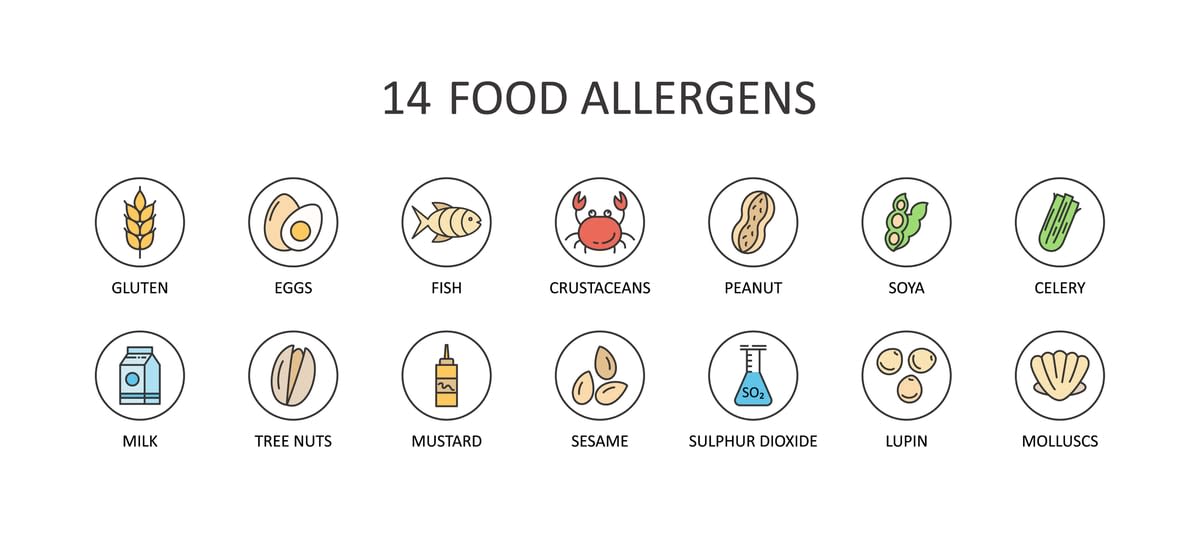If you’ve ever wondered if you have a food allergy or intolerance, you’re not alone. Adverse reactions to food are common, and estimated to affect around 20 per cent of people in Western countries. And while potentially life-threatening, they’re increasingly ‘diagnosed’ using unorthodox, scientifically unsound methods.
Adverse reactions to food can be divided into reactions with an immune basis (food allergies and coeliac disease), or those without an immune basis, known as food intolerances.
Food allergies
Food allergy is an adverse immune-mediated response, which occurs reproducibly on exposure to a given food, and is absent during avoidance.
Food allergies affect about 1–2 per cent of adults and fewer than 10 per cent of children. They typically arise in the first two years of life and prevalence appears to be rising in Western nations, particularly among children. In Australia for example, hospital admissions for food anaphylaxis rose fourfold between 1998–99 and 2011–12.

The most common food allergy triggers are egg, cows’ milk (dairy), peanut, tree nuts, sesame, soy, wheat, fish and other seafood, although almost any food can trigger an allergic reaction.
While some food allergies such as cow’s milk and egg are often outgrown, others such as fish, shellfish, peanut and tree nut allergies more often persist into adulthood.
Allergic reactions to food range in severity from mild to severe. While mild to moderate symptoms include swelling of face, lips and/or eyes, hives or welts on the skin, stomach (abdominal) pain and vomiting, severe allergic reactions (anaphylaxis) affect breathing and the heart, and can be life-threatening. Sensitivity to allergens varies, but for some people, exposure to even trace amounts can trigger a severe reaction.
Allergic reactions are, of course, preventable, but this requires careful avoidance of the food allergen (in people with a diagnosed food allergy) and in the case of a reaction, the immediate administration of adrenaline (epinephrine) via an auto-injector device (for example, EpiPen or Anapen).

In Australia, the Australasian Society of Clinical Immunology and Allergy (ASCIA) also advises that the likelihood of developing food allergies may increase if the introduction of solid foods is delayed until after 12 months of age. It’s therefore recommended that:
- a variety of solid foods are introduced to babies by six months, but not before four months, starting with iron-rich foods, and while continuing breastfeeding
- all infants (including those at high risk of allergy) should be given allergenic solid foods including peanut butter, cooked egg, dairy and wheat products in their first year
- hydrolysed infant formulas are not effective for the prevention of food allergies.
Diagnosis of food allergy requires a careful clinical examination, along with reliable, evidence-based testing. Recommended tests include:
- skin prick and blood tests to measure allergen-specific antibodies known as immunoglobulin
- food allergen challenges that involve the patient consuming the suspected allergen in a medically supervised environment using established protocols, to confirm or exclude food allergy.
At present, the only evidence-based treatments for food allergies are:
- identification and careful avoidance of the allergen
- adrenaline (epinephrine) for the treatment of life-threatening anaphylaxis.
While oral immunotherapy (OIT) shows promise as a treatment for food allergy, in Australia it’s not yet a routine therapy, but trials are underway to help determine its safety and effectiveness.
Oral immunotherapy involves exposing the patient to gradually increasing amounts of the food allergen under medical supervision, followed by continued daily consumption. The goal is to achieve desensitisation, whereby there’s a temporary increase in the amount of allergen that the patient can consume before an allergic reaction is triggered.
Food intolerances
Food intolerance is distinct from food allergy, although distinguishing between the two is difficult and requires a detailed history by an allergist, investigations to exclude other diagnoses, and allergy testing to exclude food allergy.
Food intolerance describes a wide range of adverse reactions to food and/or food components that are not immune-mediated. They’re often dose-dependent, whereby a threshold level of exposure triggers symptoms, and these may worsen with increasing intake. Various physiological mechanisms drive food intolerances, including:
- pharmacological effects (for example, caffeine, tyramine, monosodium glutamate, salicylates and amines)
- enzyme deficiencies (lactase deficiency causing lactose intolerance)
- toxins (contamination of food such as fish with bacteria or their by-products)
- gastrointestinal dysfunction (visceral hypersensitivity in irritable bowel syndrome leading to FODMAP sensitivity).
Symptoms of food intolerance are also varied, and can include stomach pain, bloating, distension, excessive flatulence, diarrhoea, rashes, hives (urticaria), recurrent mouth ulcers, and headaches.
Gastrointestinal symptoms are particularly common, with more than 60 per cent of people with irritable bowel syndrome (IBS) perceiving that food triggers IBS symptoms.
But pinpointing the culprit food or food component is difficult. This is because:
- food and diets are complex mixtures of different food components
- there are multiple mechanisms by which food can trigger intolerance
- there may be considerable delay between food ingestion and symptom onset
- designing intervention studies to identify culprit food components is difficult.
Foods and food components commonly implicated in triggering food intolerance include:
- short-chain fermentable carbohydrates (FODMAPs) – excess fructose, lactose, sorbitol, mannitol, fructans and galacto-oligosaccharides
- gluten (in the absence of coeliac disease)
- wheat and/or components of wheat (in the absence of coeliac disease) such as
amylase/trypsin inhibitors and wheat lectin agglutinin - food chemicals such as salicylates, vasoactive amines (for example, histamine), glutamates (monosodium glutamate) and caffeine
- food containing excess histamine such as spoilt fish, leading to scombroid food poisoning
- sucrose and starch (in the case of sucrase-isomaltase deficiency)
- fatty foods and spicy foods.
With the exception of tests for lactose and sucrose intolerance, there are no reliable tests to diagnose food intolerance. Instead, after a detailed diet and clinical history, and tests to exclude food allergies and/or other diagnoses, diagnosis of food intolerance generally follows a temporary elimination-rechallenge approach.
This should be followed under the guidance of an experienced dietitian, and requires the patient to follow a temporary elimination diet that excludes the suspected food component. If symptom relief is achieved, foods are systematically reintroduced to determine which foods are tolerated, and which trigger symptoms. Long-term, a minimally restrictive diet that only restricts trigger foods should be followed by the patient.
But the elimination-rechallenge method of diagnosing food intolerance has its drawbacks. The diet is long and cumbersome, leading to non-compliance and ambiguous results. It is also highly restrictive, with negative nutritional and psychological consequences. Of major concern is the lack of evidence to support the efficacy of restricting particular dietary triggers.
Unreliable tests for food allergy/intolerance
There’s an abundance of non-evidence-based allergy and food intolerance tests that may be offered by unorthodox/alternative practitioners. These tests are characterised by a lack of supportive scientific evidence, poor correlation with evidence-based tests, and inconsistent findings when repeated in the same person. Examples include:
- Immunoglobulin G (IgG) food panel testing. IgG antibodies (as distinct from immunoglobulin E antibodies) are measured from a blood sample, and their presence indicates allergy or intolerance to hundreds of potential foods.
- Electrodermal (vega testing). This technique detects allergies by measuring changes in electrical currents within the body using a ‘vega machine’. The patient holds a negative electrode in one hand, while the positive electrode is applied to acupuncture points on fingers or toes. The allergen is introduced to the electrical circuit, and if an alteration in the current is detected, this indicates sensitivity.
- Pulse testing. This test measures the pulse after a suspected allergen is consumed. A sensitivity is diagnosed if the pulse increases after consumption.
- Bicom (bioresonance) testing. This test claims to detect abnormalities in electromagnetic emissions by body tissues using electrodes.
- Cytotoxicity testing or Alcat tests. White blood cells are collected from a sample of blood. These cells are mixed with the suspected food allergen and viewed under a microscope. Changes in the appearance of cells indicate an allergy.
- Hair analysis. This either measures the ‘electromagnetic energy’ of the hair sample when it’s in contact with the suspected allergen, or measures mineral content of the hair sample.
- VoiceBio. This technique analyses the person’s voice, and draws conclusions regarding soundwave frequencies, organ dysfunction, and the presence of food allergies/intolerances.
- Kinesiology. Muscle strength is measured after exposure to a suspected allergen, with a reduction in muscle strength indicating exposure to an allergen or ‘toxic’ substance.
There are numerous concerns about these non-evidence based tests. For example, they:
- use scientifically unfounded methods
- provide unreliable results
- are expensive and unregulated
- potentially mislead patients into thinking that a true allergen is safe to consume
- lead to unnecessary dietary restrictions (and potentially to nutritional inadequacies and food related anxieties)
- delay access to reliable testing methods.
Despite the lavish claims of test providers, many tests for food allergies and tolerances are far-fetched and unfounded.
If you suspect you have a food allergy or intolerance, consult a medical practitioner who can take a detailed history, request appropriate investigations, supervise any allergy testing, and refer you to an experienced dietitian for dietary management.
This article was first published on Monash Lens. Read the original article
Do you have a food allergy or intolerance? How was it diagnosed? How does it affect your day-to-day life? Let us know in the comments section below.
If you enjoy our content, don’t keep it to yourself. Share our free eNews with your friends and encourage them to sign up.

